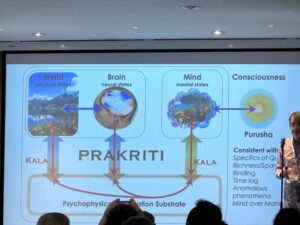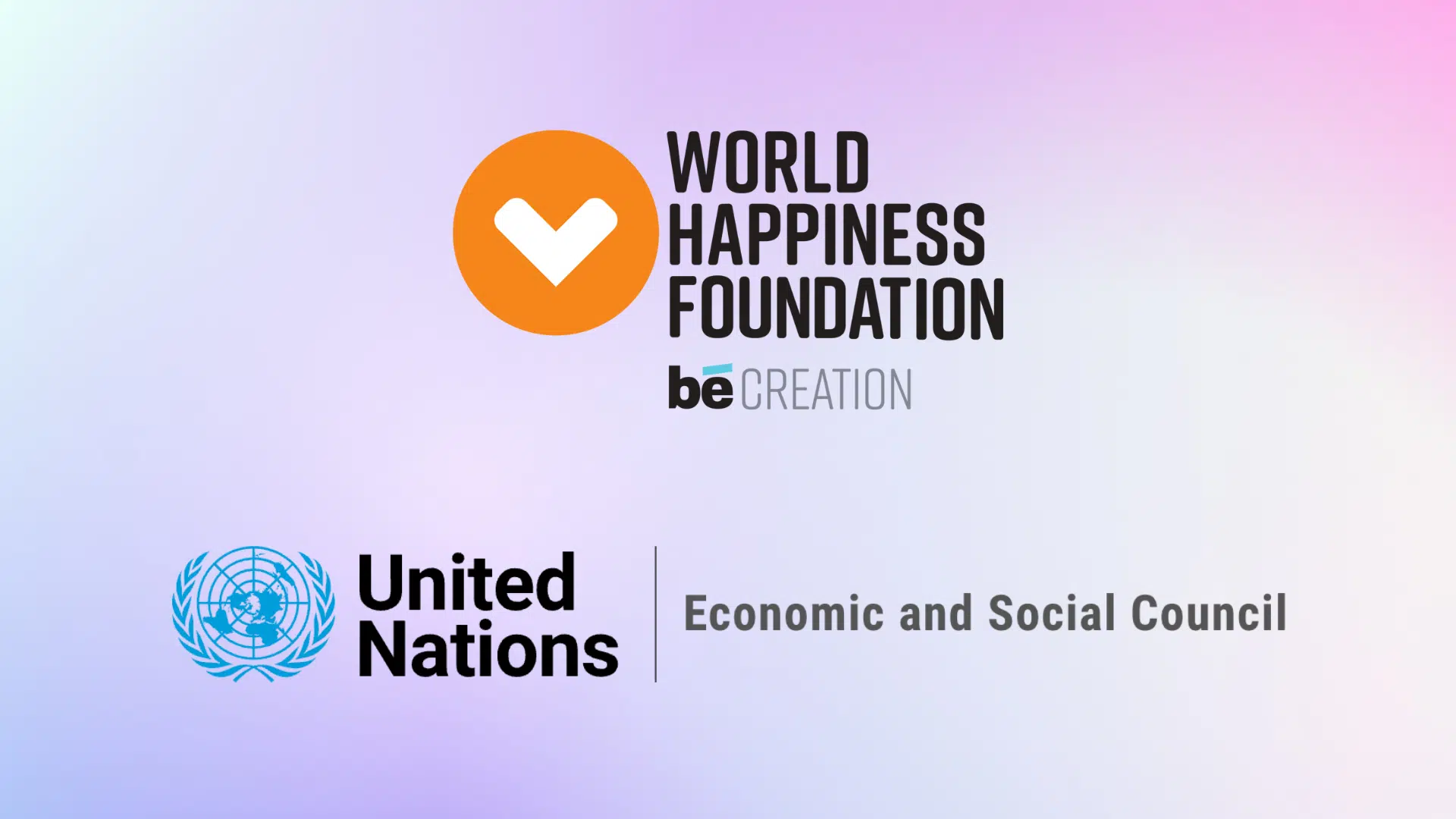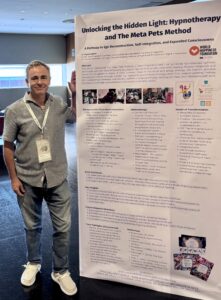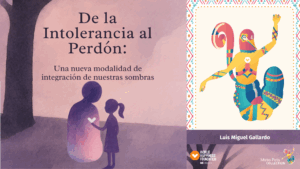
Quantum Consciousness: Bridging Science, Soul, and Self-Integration at The Science of Consciousness Conference in Barcelona
As Barcelona pulses this week with the presence of leading

By Luis Miguel Gallardo, President of the World Happiness Foundation
The World Happiness Foundation’s first official statement with UN ECOSOC consultative status calls for a holistic peace built on disarmament, dialogue, and global well-being.
Standing before the United Nations as President of the World Happiness Foundation, I feel the weight of history and hope on my shoulders. Our organization recently achieved Special Consultative Status with the UN Economic and Social Council, and with it came a profound opportunity—and responsibility—to amplify our message of peace and well-being on the world stage. In our first official statement as an ECOSOC-affiliated voice – “World Happiness Foundation Response to ‘A Call for Peace: The End of Wars and Respect for International Law’” – we formally endorsed a bold UN-led appeal for an end to war and a return to dialogue. This statement is far more than a policy position; it is a heartfelt declaration of our core belief: that peace and human happiness are inseparable, and that the pursuit of one cannot succeed without the other.
I write this opinion piece not only to announce that milestone statement, but to reflect on its deeper meaning. It marks a convergence of my life’s work and vision—concepts I call Fundamental Peace and Happytalism—with the urgent global discourse on peace and human rights. In a world beleaguered by conflict, “a growing culture of militarization,” and human suffering, we offered our voice in unity with those calling for dialogue, justice, and respect for international law. We fully endorse the principle that today’s wars are “solvable through dialogue” and that lasting peace is the foundation of societal happiness, sustainable development, and human flourishing. The special consultative status afforded to us is not a badge of prestige, but a beacon—a chance to light the way toward a new paradigm where global policies put people’s well-being first.
Our official statement to the UN grew from a simple conviction: peace is inseparable from human happiness and well-being. This idea may sound aspirational, but it is grounded in both ethical philosophy and practical reality. Philosophically, if we accept that every human being has a right to pursue happiness, then surely they have a right to live free from war, violence, and fear. Structurally, no society can hope to flourish—economically or socially—under the shadow of conflict. The absence of peace inevitably means the presence of suffering, trauma, and despair, which poison the roots from which happiness grows. Conversely, a peaceful society creates the conditions for individuals and communities to thrive in freedom and harmony. As we noted in our statement, a peaceful world is the bedrock upon which we can build “sustainable development and human flourishing”. In short, peace and happiness stand or fall together.
This inseparability informed every word of our UN statement. We commended the joint initiative by global leaders – from the UN Alliance of Civilizations to Religions for Peace – who issued the original “Call for Peace” that inspired our response. Their call underlines that humanity must shift toward resolving conflicts through dialogue, justice, and the rule of law, rather than through violence. We echoed this loudly. Indeed, one of the core principles we highlighted is a universal renunciation of violence as a means of settling disputes – to be replaced by dialogue and restorative justice. Imagine the transformation if nations and groups, instead of meeting bullets with bullets, met at the negotiating table with open hearts and minds. Such a shift from force to conversation is not naive; it is increasingly necessary in a world where wars across all continents are wreaking untold human misery, yet are ultimately “solvable through dialogue” if we are courageous enough to try.
Our statement didn’t stop at broad principles; we laid out concrete recommendations that connect peace and well-being. We called for nothing less than complete global disarmament and demilitarization, far beyond just the abolition of nuclear weapons. This may sound utopian, but it is a practical necessity when, as former UN Secretary-General Ban Ki-moon warned, “the world is over-armed, and peace is underfunded.” Every dollar diverted from weapons to schools or hospitals is a step toward a happier, more secure world. We likewise urged a “democratic renovation” of global institutions—especially the United Nations itself—to ensure they represent all of humanity and even the voice of nature. Why include nature? Because our well-being is intertwined with the health of our planet, peace is not only the absence of war but the presence of harmony between humanity and the Earth that sustains us.
One recommendation especially close to my heart was the integration of Peace and Happiness curricula in education systems worldwide. This means teaching our children emotional intelligence, compassion, mindfulness, and conflict resolution from an early age. If we cultivate inner peace and empathy in individuals, we sow the seeds of a more peaceful society. As I often say, peace is not just a treaty to be signed—it’s a skill to be learned and a value to be lived. By educating for peace and happiness, we address the roots of violence and unhappiness before they can take hold. Such education initiatives reflect the structural importance of advocating for happiness as a goal: we must redesign our institutions—schools, workplaces, governments—to prioritize well-being and not treat happiness as an afterthought.
These ideas of linking inner change with outer change are at the core of what I call Fundamental Peace. In essence, Fundamental Peace is the notion that true peace blossoms when we achieve harmony both within ourselves and in our societies. It is a peace defined by a triad of values—freedom, consciousness, and happiness—which must be present in individuals and in the collective for peace to hold. Think of it as a three-legged table: if one leg is weak or missing, the table cannot stand steady. A society cannot be at peace if its people are not free, aware, and content; and an individual cannot be truly happy and free while living in an unjust, conflict-ridden society.
Fundamental Peace marries the forces of inner and outer peace. On the personal level, this means nurturing inner balance, self-awareness, and compassion, peace within. On the societal level, it means building justice, dialogue, and understanding among communities and nations, peace among. There is a feedback loop between the two: when we carry peace within us, we become better citizens and leaders, more capable of fostering reconciliation and understanding around us. And when our society commits to peace, it creates an environment where individuals are less traumatized, more secure, and thus more able to find inner calm and happiness.
The concept is deeply influenced by what peace researchers call negative peace (the absence of violence) and positive peace (the presence of justice and constructive cooperation). Fundamental Peace encompasses both. It starts from the insight that “anything in the world can be transformed when we transform ourselves”. If we want external peace—no wars, no oppression—we must cultivate internal peace in billions of hearts. This is why our movement often emphasizes meditation, mindfulness, and emotional well-being alongside policy proposals. Likewise, if we seek personal happiness and tranquility, we must also engage in the work of building a more just and peaceful global community. As I wrote previously, peace can be thought of as peace within, peace between, and peace among—it starts with one, but it ends with everyone.
Our first UN statement’s recommendations mirror this holistic view. Disarmament and demilitarization address peace among nations, tackling the external machinery of war. Renouncing violence and promoting dialogue addresses peace between groups, healing relationships. Peace education and inner skills address peace within individuals. And underlying all of these is the pursuit of societal arrangements that free people from fear and want—enabling them to be happy. This is Fundamental Peace in action: aligning our inner values with systemic change. It’s an ambitious vision, but I truly believe that nothing less will suffice if we are to break the cycles of conflict and suffering.
To achieve Fundamental Peace, we must also rethink the very paradigm that drives our global development. This is where Happytalism comes in. Happytalism is the term I use for a new system—a new “-ism” – that places happiness and well-being at the center of our social, economic, and political life. It is, in many ways, a response to the shortcomings of old paradigms. For too long, the world chased GDP growth and material wealth under systems like capitalism or socialism, often forgetting that those are means, not ends. The end we truly seek is happier lives, healthier communities, and a sustainable planet. Happytalism says: let’s make human flourishing the ultimate measure of progress. Let’s build an economy and society that prioritize people’s happiness as sincerely as we prioritize profits or power.
This idea is not just an idealistic musing; it is gaining traction globally and even within the UN. In 2012, all 193 UN member states unanimously agreed that happiness should be a core focus of public policy, adopting a resolution that called for “a holistic approach to development” and even for defining a “new economic paradigm” beyond GDP. The first UN High-Level Meeting on Happiness and Wellbeing that year explicitly urged the world to consider happiness as a human right and a new paradigm for development. Happytalism is my answer to that call. It’s an emerging paradigm that redefines success: instead of judging our societies solely by output and income, we judge them by how well they deliver happiness, wellbeing, and freedom for all life on earth. In practical terms, this means advocating policies like mental health support, community building, environmental sustainability, and poverty eradication as central investments, not side projects. It means businesses measuring “profit” in terms of human and ecological wellbeing alongside financial returns. It even means recognizing that happiness itself can be considered a fundamental human right, a goal that governments have a duty to advance just as they do education or healthcare.
At the World Happiness Foundation, we have been focusing on human flourishing and building the capabilities of individuals, communities, organizations, and governments to accelerate progress toward happiness and well-being for all. This is the essence of Happytalism in practice. It has two pillars: individual development and collective development. On the individual side, we encourage personal growth, mindfulness, and mental health because empowered, self-aware individuals form the fabric of a thriving society. On the collective side, we champion social cohesion, equitable economic systems, and respect for nature—because supportive communities and a healthy planet are non-negotiable for lasting happiness. In short, Happytalism is about nurturing what makes life worth living. It’s about ensuring that the pursuit of happiness is not a trivial pursuit, but a guiding principle of civilization.
Our first UN statement was a chance to infuse international policy with this vision. When we insisted on reallocating military expenditure toward sustainable development, we were invoking Happytalist logic: invest in people’s well-being, not instruments of destruction. When we urged educating for peace and happiness, we were saying: let’s redefine the purpose of education to include happiness as a skill and outcome, not just job readiness. When we advocated for a more democratic UN that gives voice to the vulnerable and to nature, we echoed our belief that empathy and connectedness should guide governance. All these recommendations flow from a Happytalist understanding that global wellbeing and peace are two pillars of the same temple. You cannot have one without the other, and both are required to support the grand edifice of a truly prosperous world.
Declaring happiness a human right might raise some eyebrows. After all, happiness can seem subjective or personal. But consider what it really means: it means affirming that governments and institutions exist to serve the holistic well-being of people, not just to manage resources or resolve conflicts. Philosophically, this idea goes back to the Enlightenment—Thomas Jefferson wrote of the “pursuit of happiness” as an inalienable right. Today, neuroscience and psychology reinforce that things like emotional health, social connection, and sense of purpose are not luxuries; they are as vital to a good life as food and shelter. So why shouldn’t our social contracts guarantee the conditions for happiness?
Recognizing happiness as a human right also has structural implications. It urges leaders to ask, “Will this policy increase or decrease the genuine well-being of the people?” at every turn. It means we must develop measures of progress that include happiness – as countries like New Zealand, Bhutan, and others have begun to do with well-being budgets or Gross National Happiness indices. At the UN, this ethos was captured in the 2011/2012 resolutions that led to the International Day of Happiness and the idea of Gross Global Happiness. Those were watershed moments where policy caught up with common sense: that economic growth devoid of human happiness is an empty victory. Now, with our consultative status, we aim to further weave this ethos into the fabric of international cooperation. That is why we speak of Happytalism alongside fundamental peace—because establishing peace is essentially securing the right of every human being to live a happy, healthy life free from fear and want. Advocating happiness as a human right reframes peace not merely as the absence of war, but as the presence of conditions that allow everyone to thrive. It is a philosophy of governance that places human dignity and joy at the forefront, and a structure for policymaking that measures success by the smile on a child’s face as much as by the size of a nation’s GDP.
Writing our first statement as a UN-recognized organization was a personal milestone, but its true value will be measured by what comes next. This moment is a call to action for the general public, policymakers, UN colleagues, and changemakers everywhere. I invite each of you reading this to embody the ideals of happiness and peace in your own domain. Peace, in all its dimensions, must become our legacy for future generations. That means parents teaching children kindness and empathy at home. It means educators embracing social-emotional learning and cultures of peace in schools. It means CEOs measuring success not only in quarterly profits but in employee well-being and community impact. It means presidents and prime ministers daring to budget less for arms and more for art, mental health, and nature conservation. It means each of us treating our own and others’ happiness as precious and recognizing that the suffering of any human being diminishes us all.
The World Happiness Foundation’s mantra, #TenBillionHappyBy2050, may sound like a dream—but it is a dream we are actively pursuing. By 2050, the Earth will host around ten billion souls. We envision a world by then where all ten billion can live with basic peace, freedom, and the opportunity to pursue happiness. Achieving this will require a profound global shift, but it begins with simple steps taken by individuals and institutions today. Support a peace initiative. Practice compassion in your daily interactions. Advocate for policies in your city or country that prioritize mental health, education, equality, and sustainability. Connect with global networks—like our World Happiness Agoras and forums—that are working to spread well-being and resolve conflicts through understanding. There is a role for everyone in this movement, from grassroots volunteers to international diplomats.
Our first UN statement is now on record, but it will have meaning only if we collectively bring it to life. The journey ahead is as personal as it is political. It calls us to be the peace and happiness we wish to see in the world—to cultivate Fundamental Peace in our hearts and to demand Happytalist change in our systems. I am optimistic because I see a rising consciousness across the globe: people are increasingly aware that happiness is not a frivolity but a profound indicator of progress and a unifying goal for humanity. We are recognizing that peace is not just a treaty or the silence of guns, but a positive, living state of coexistence that we build together each day.
As I reflect on this milestone, I am filled with gratitude and determination. Gratitude for all those—from UN officials to grassroots activists—who have laid the groundwork by insisting that happiness and peace are worth working for. Determination to ensure that our Foundation’s new consultative voice is used to its fullest potential to advance this vision. We have much work to do. But I believe that by embracing the ideals of Fundamental Peace and Happytalism, by treating happiness as a human right and peace as the prerequisite for global well-being, we can indeed bend the arc of history toward a brighter future. Together, let us make peace, in all its dimensions, our legacy for future generations—and in doing so, secure the happiness and dignity of all people, for all time.
Sources: The official statement of the World Happiness Foundation in response to “A Call for Peace: The End of Wars and Respect for International Law”; Gallardo, Luis—Fundamental Peace (World Happiness Foundation blog); Gallardo, Luis—Embracing Happytalism: A New Paradigm for Achieving Fundamental Peace; United Nations International Day of Happiness 2020 Campaign (World Happiness Foundation).
#WorldHappinessFoundation #ECOSOC #UNPeace #FundamentalPeace #Happytalism #PeaceAndHappiness #GlobalWellBeing #TenBillionHappy #HumanRights #HappinessIsARight #GlobalPeace #InnerPeace #PeaceEducation #DemilitarizationNow #DialogueForPeace #ConsciousLeadership #PositivePeace #HolisticDevelopment #HappinessMovement #MentalHealthMatters #WellBeingEconomy #SustainableHappiness #PeaceStartsWithin #UNHappinessResolution #GlobalFlourishing #TransformTheWorld #NewParadigm #HappinessForAll #HappytalistFuture #LuisGallardo
Let’s keep transforming—one shadow, one gift, one Meta Pet at a time.
With joy, Luis Miguel Gallardo Author of The Meta Pets Method | PhD Candidate | Professor of Practice Yogananda School of Spirituality and Happiness | Founder, World Happiness Foundation | Author, Unlocking the Hidden Light
#ShooliniUniversity #PhDJourney #ProfessorOfPractice #Hypnotherapy #EasternWisdom #WesternScience #SpiritualPsychology #ShivDhar #SoulfulLeadership #NatureHeals #YoganandaSchool #Himalayas #NonDuality #MetaPets #UnlockingTheHiddenLight
Explore the future of leadership:
Join our Alchemy of Leadership Program: https://www.worldhappinessacademy.org/offers/ezL8GGWJ
Join our community of Global Well-Being and Impact Leaders:
Apply here: Global Well-Being and Impact Leadership Certification – Application Page
Join us in this bold journey. Let’s champion a new paradigm of leadership together – one where happiness, well-being, and impact are at the heart of every strategy and every action.
Become a part of GWILC and help realize the vision of a world where everyone, everywhere can thrive in freedom, consciousness, and happiness. The next seven years of global leadership evolution start now – and we invite you to lead the way.
#LeadWithWellBeing #GWILC #Happytalism #GlobalLeadership #WorldHappiness
Join the Chief Well-Being Officer Program: https://www.worldhappinessacademy.org/english-chief-well-being-officer
….join the Cities of Happiness Initiative: https://www.teohlab.com/city-of-happiness
Unlocking the Hidden Light book: https://a.co/d/gaYuQJ6
Join the pull of Mental Health Professionals ready to help addressing trauma and nurturing collective well-being: https://forms.gle/39bGqU177yWcyhSUA
Join the community of catalysts of positive transformation: https://www.worldhappiness.academy/bundles/certified-chief-well-being-officer-professional-coach
Enjoy a free 30-minute coaching session with me. Book it here: https://www.worldhappiness.academy/courses/coaching-and-hypnotherapy-with-luis-gallardo
Link to Meta Pets Coloring Book
For more information and to join the movement, visit World Happiness Foundation.
#WorldHappinessFest #Happytalism #GlobalHappiness #WellBeing #Sustainability #ConsciousLiving #WorldHappinessFoundation #FreedomAndHappiness #GlobalWellBeing
Jaipur Rugs Jaipur Rugs Foundation Upasana Design Studio World Happiness Fest – bēCREATION World Happiness Academy University for Peace (UPEACE) – UN Mandated UPEACE Centre for Executive Education Saamdu Chetri Manas Kumar Mandal Dr. Rekhi Singh REKHI FOUNDATION FOR HAPPINESS Adamas University Shoolini University Saamdu Chetri Vibha Tara Manas Kumar Mandal Prof. (Dr.) Shauli Mukherjee

As Barcelona pulses this week with the presence of leading

What does it feel like to be alive? This is

Mi nombre es Luis Miguel Gallardo, y quiero compartir con
